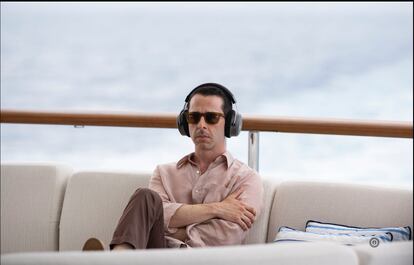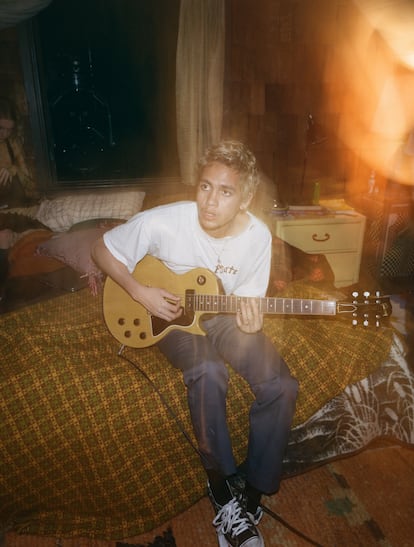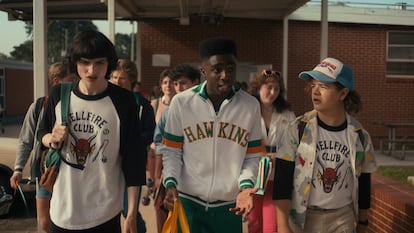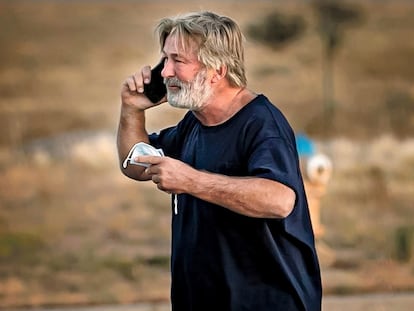From ‘Stranger Things’ to ‘Peaky Blinders’: all the current fashion trends come from TV shows
In the era of streaming platforms, programs no longer seek just to entertain people or spread social and political messages. Now they also have a not-so-secret economic agenda: making runway trends go viral in order to sell clothes
A scene in the first season of HBO’s Succession condenses many of the dilemmas that the fashion industry has forced upon men in recent years. The heir Kendall Roy, played by Jeremy Strong, attends a meeting to try to reach an agreement with a young tech company. In the car on the way to the start-up’s office, the aspiring business mogul changes his footwear, switching out his custom-made dress shoes for a pair of luxury athletic sneakers. But he still doesn’t fit in: surrounded by workers in New Balance, his discomfort grows as the seasons progress. The Roy of yesteryear finds himself buried under sweatshirts, extra-large tees, hats and chains, in an attempt to adopt the streetwear that for him is a symbol of the changing times. For the spectator, his outfits become a metaphor for all the business opportunities that he misses. The online magazine The Cut cited the scene in an article about the series’ costume, titled, “Succession Shows How It Looks to Have Too Much Money and No Style.” At the same time, though, online articles proliferated linking directly to the online store that sold the shoes in question.
The relationship between streaming shows and fashion is an inevitable symbiosis, but it is more recent than it seems. “Television and film are often the launching point for many fashion trends, as fans try to imitate the style of their favorite characters,” says Olie Arnolds, fashion director at luxury fashion platform Mr Porter, one of the primary such stores dedicated to men’s clothing. “It’s not a very obvious phenomenon, but there is no doubt that there is a trickle-down effect in the way men are influenced by audiovisual content. Men who consume fashion tend to be more attentive to television and movies.”

“Now series are much more self-aware than 15 years ago,” explains fashion specialist Anabel Vázquez. “Today the idea of a series being a possible platform for clothing sales is clear from the start, but I don’t think anyone thought that in the first episode of Mad Men. Those were much more innocent regarding their commercial possibilities. Today’s series, in addition to social and political objectives, have an economic agenda. They have work to do besides just entertaining people.”
It is no coincidence that Vázquez cites Mad Men as an example when establishing this relationship. The series by Matthew Weiner, which aired between 2007 and 2015, recounted the rise of the marketing business in New York in the 1960s through characters dressed in stylized versions of the American clothing of the time. For menswear, it was the style equivalent of Sex and the City: it coincided with a resurgence of retro tailoring and a reinterpretation of masculinity. It was a boom for brands such as Brooks Brothers, the American store that supplied the businessmen of the 1960s and delved into its archives to create a commercial collection with the show’s wardrobe team.
Today, this practice is at its peak. In 2015, Mr Porter launched a collection linked to the costumes of Kingsman (Matthew Vaughn, 2014), the saga of spy films based in Savile Row, the temple of London tailoring. Seven years and two sequels later, the project is still active. “It was a very innovative gesture in this sector because it inaugurated the concept of ‘from the wardrobe to the collection,’ allowing men to buy part of the franchise through the same garments that appeared in the 2015 film. There was a real synergy,” Arnolds points out. “It’s an important brand for us, which grows when a new movie is released.” Today, the Kingsman line includes not only its own products, but also ones from brands with similar aesthetics: Turnbull & Asser, Cutler & Gross, George Cleverley footwear, Smythson leather goods or Montblanc writing instruments. “Now there is a whole Kingsman universe that can be bought,” explains the fashion director.

Action movies are a natural advertising destination for menswear, but also for luxury brands. The James Bond of No Time to Die (2021) did not remove his Omega watch. Ryan Gosling’s character in The Invisible Man (2022) was never seen without his TAG Heuer. In both cases, the pieces are not just wardrobe choices, but paid agreements: Omega is the official watch of 007, and Gosling is an ambassador for TAG Heuer. Both releases were accompanied by limited edition watches.
But not everything is classicism and virility, despite the fact that the influence of series like Peaky Blinders or movies like The Gentlemen (Guy Ritchie, 2019) have saturated the men’s style market with caps, three-piece suits and establishments — barbershops, cocktail bars and tailor shops — that could easily have their own illegal boxing club in the back room. Last September, the luxury firm N.Peal released the results of its own study that analyzed the impact of series premieres on internet fashion searches. It found, for example, that searches for “Y2K fashion’ increased 18-fold after the premiere of the second season of Euphoria (HBO).

In turn, the broadcast of the fourth season of Stranger Things (Netflix) tripled searches for scrunchies like the one Eleven wears in the series. It also inspired searches for shearling jackets (up 99%) and Hawaiian shirts (up 46%). The Netflix teen series has become the gold standard for monetizing style. In addition to the merchandise that the platform sells in its own digital store, Stranger Things has starred in endless collaborations with brands that either are aimed at its target audience, such as Topman and Pull & Bear, or evoke its 1980s imagery, such as Vans, Eastpak and Timex. But its rise has also coincided with Generation Z’s interest in second-hand clothing stores. Few nostalgias are so powerful as that felt for an era before one’s time.
At a moment when luxury brands are aspiring to conquer clients between 15 and 25 years of age, the wardrobe for shows aimed at that audience has become a weapon of mass seduction. In the first episode of We Are Who We Are (HBO and Filmin), the leading role fell both on Jack Dylan Grazer and on the printed Raf Simons T-shirt that caught the attention of the residents of a very normative US military base on Italian soil. After each new episode of Euphoria, social media users dissect the characters’ outfits and identify the clothes they wear, most of them from the current season and on sale at the time of the premiere. It is a recent practice. As Vázquez explains, one of the keys to Succession was to dress its characters in the very expensive clothes that their real-life counterparts would wear. “They could have gone with vintage or tailored clothing, but they stuck with the big brands,” she says. Something similar has happened with The White Lotus, whose reflection of the vacation style of the elite has provoked plenty of analysis.

But even a period series like Bridgerton (Netflix), the romantic drama set in Georgian England, makes its mark on the streets. Last year, the British Fashion Council, the public body that promotes the creation of fashion in the United Kingdom, collaborated with Netflix to launch a project with emerging designers based on the series by Shonda Rhimes. “This long-standing partnership is testament to fashion’s role within culture and its importance within entertainment and TV,” explained Gemma Juviler, the council’s commercial director. This year, the second edition of the project has brought designs such as those by Ifeanyi Okwuadi, who created patterned suits whose blue tones are reminiscent of the Wedgwood crockery that also appears in the series.
As part of a generation of British designers who have offered their own take on Victorian design —as shown by S. S. Daley, winner of the latest LVMH Prize, and the decorator Luke Edward Hall—, Ifeanyi Okwuadi demonstrates that globally successful historical fiction can also inspire alternative aesthetics. Not even the present is decisive. When, last January, actor Kyle MacLachlan stepped onto the Prada catwalk amidst a Lynchean set design —green carpet and upholstered walls, hundreds of midcentury-style armchairs— the public not only saw the aesthetic experiment of Miuccia Prada and Raf Simons, but also Dale Cooper, the character who made MacLachlan famous in Twin Peaks. In the era of streaming, not even time is linear: a very Lynch phenomenon, but also very typical of fashion.
Tu suscripción se está usando en otro dispositivo
¿Quieres añadir otro usuario a tu suscripción?
Si continúas leyendo en este dispositivo, no se podrá leer en el otro.
FlechaTu suscripción se está usando en otro dispositivo y solo puedes acceder a EL PAÍS desde un dispositivo a la vez.
Si quieres compartir tu cuenta, cambia tu suscripción a la modalidad Premium, así podrás añadir otro usuario. Cada uno accederá con su propia cuenta de email, lo que os permitirá personalizar vuestra experiencia en EL PAÍS.
¿Tienes una suscripción de empresa? Accede aquí para contratar más cuentas.
En el caso de no saber quién está usando tu cuenta, te recomendamos cambiar tu contraseña aquí.
Si decides continuar compartiendo tu cuenta, este mensaje se mostrará en tu dispositivo y en el de la otra persona que está usando tu cuenta de forma indefinida, afectando a tu experiencia de lectura. Puedes consultar aquí los términos y condiciones de la suscripción digital.
More information
Últimas noticias
James Cameron: ‘For the films I like to make to continue to exist, we have to find a way to make them cheaper’
Families demand repatriation of bodies of Colombians who died in Ukraine: ‘This war is a slaughterhouse for foreigners’
The guardians of the meteorites of the Argentine Chaco
Helen Levitt, the photographer who captured the theater of the everyday
Most viewed
- Christian Louboutin: ‘Young people don’t want to be like their parents. And if their parents wear sneakers, they’re going to look for something else’
- US sanctions against jailed cartel leader ‘El Marro’ highlight Mexico’s lack of control over its prisons
- Cartels in Mexico take a leap forward with narco-drones: ‘It is criminal groups that are leading the innovation race’
- Liset Menéndez de la Prida, neuroscientist: ‘It’s not normal to constantly seek pleasure; it’s important to be bored, to be calm’
- ‘El Limones’ and the growing union disguise of Mexican organized crime












































